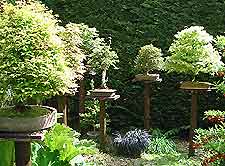Bonsai Trees
Accent Plantings

Accent or 'companion' plantings as they are sometimes known are grown to complement bonsai trees when being exhibited. They are placed near the bonsai and often reflect the tree's character, adding a natural element to the display.
A plant slightly pendulous in growth habit may be suitable when displayed next to a weeping willow. Tall, narrow literati trees are enhanced with slender grasses, which mirror the mood of the tree and suggest scale. A strong feeling of season can also be represented by using small spring bulbs, plants with autumn colours or in winter, grasses that are beginning to die back.
A good accent plant can be charming in its own right and may be displayed on its own or as part of a group. However, when next to a bonsai tree it must not be overpowering or become the dominant feature. Good health is also essential. A yellow, deficient grass will draw attention to itself, but so also will a very lush specimen grass that is unusually large and robust. Creating a happy medium is important. Mixed accent plantings using different species in the same pot can be effective, but also difficult to create. It is often not practical to combine plants that require different growing conditions. More often just one plant is used, possibly under planted with moss or similar ground cover. Growing an accent plant directly on a rock can also be pleasing, appearing natural and realistic.
Accents plants are very quick to mature and easy to create, adding another dimension to the hobby. Being relatively small, they also have the added advantage of being fairly inexpensive, both the plant and the pot! A good way to achieve quick results is to purchase three small plants at minimal cost and plant them all closely in one pot. This ensures the appearance of an established plant in no time at all.
Species and Plants
So many different species and varieties of plants are suitable for accent plantings that the possibilities are almost endless and it becomes a matter of individual choice. Even plants normally considered to be weeds can be utilised to good effect.
There is only one drawback to having a collection of accent plants - you can get 'carried away' and end up with more accents than actual bonsai trees!
Many different species and varieties of plants are suitable for accent plantings, such as:
- Grasses
- Bamboos
- Sedges
- Herbs
- Herbaceous plants
- Small shrubs
- Ferns
- Dwarf bulbs
- Alpine plants
- Reeds/rushes
- Moss plantings
- Wild flowers
- Garden weeds
Repotting and Pruning
Growing in such small containers, it is vital that accent plants are always repotted each year and the ideal time for this is early spring. Root pruning is beneficial, providing valuable space for the roots to grow and develop. Many grasses and similar plants respond well to being cut back when repotted, which activates dormant buds. Also, by removing all old and damaged foliage at this time, more air and light is able to reach the new shoots, encouraging fresh growth. Add slow release fertiliser to the soil mix and feed throughout the summer as required, to ensure steady growth and optimum health.
Most accents should be treated as fairly short lived and it is a good idea to plant them in the garden after 2 or 3 years, where they can become stock plants and used to propagate further accents or indeed garden plants.
 Accent or 'companion' plantings as they are sometimes known are grown to complement bonsai trees when being exhibited. They are placed near the bonsai and often reflect the tree's character, adding a natural element to the display.
Accent or 'companion' plantings as they are sometimes known are grown to complement bonsai trees when being exhibited. They are placed near the bonsai and often reflect the tree's character, adding a natural element to the display.